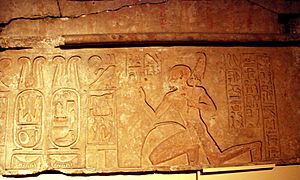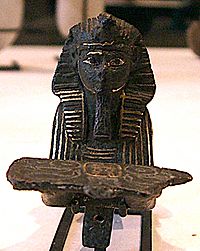Siamun facts for kids
Quick facts for kids Siamun |
|
|---|---|
| Psinaches (Manetho)? | |

Siamun on a relief, from Memphis
|
|
| Pharaoh | |
| Reign | 986–967 BC (21st Dynasty) |
| Predecessor | Osorkon the Elder |
| Successor | Psusennes II |
| Consort | Karimala? |
| Died | 967 BC |
| Burial | Unknown, possibly reburied in NRT III at Tanis |
Siamun was an important pharaoh of Ancient Egypt during the 21st Dynasty. His full name was Neterkheperre-Setepenamun Siamun. His first name, Netjerkheperre-Setepenamun, means "Divine is The Manifestation of Ra, Chosen of Amun". His name, Siamun, means "son of Amun."
Siamun built many structures in Lower Egypt. He is seen as one of the strongest rulers of the 21st Dynasty, after Psusennes I.
Contents
Siamun's Family Life
We don't know much about Siamun's family. Some historians think he might have married a queen named Karimala. She is called both "King's Daughter" and "King's Wife" in an old writing.
Karimala might have been the daughter of an earlier pharaoh, Osorkon the Elder. If Siamun married her, it could explain how he became king after Osorkon.
How Long Did Siamun Rule?
The longest reign year found for Siamun is his 17th year. This was written in ancient records from Karnak. Based on these records, experts believe Siamun became pharaoh around 986 BC and ruled until 967 BC.
An interesting fact from his 17th year is that the word "pharaoh" was used as a title directly linked to a king's name for the first time. Before Siamun, "pharaoh" usually referred to the king's office, not the king himself.
Buildings and Battles
Siamun made the Temple of Amun at Tanis much bigger. He also started building projects at the Temple of Horus at Mesen. He built in other cities like Heliopolis and Piramesse.
In Memphis, Siamun built a new temple for Amun with six stone columns. He also gave many gifts to the priests there.
In Upper Egypt, Siamun's High Priest, Pinedjem II, moved and reburied many royal mummies from the New Kingdom. This was done to protect them from robbers. These reburials happened during Siamun's first ten years as king.
One famous carving from the Temple of Amun at Tanis shows an Egyptian pharaoh hitting his enemies with a club. The carving clearly names the king as Siamun. Some historians, like Kenneth Kitchen, believe this scene shows Siamun winning a battle against the Philistines at Gezer. The enemies are shown with a special double-bladed axe, which might suggest they were from the Aegean area, like the Sea Peoples who were ancestors of the Philistines.
However, other experts like Paul S. Ash disagree. They think the battle shown in the carving might not have been real. They point out that Philistines are not usually shown with axes in Egyptian art, and there's no proof they used them.
Even so, archaeological digs at Gezer have found signs that the city was destroyed by Egyptians around the 10th century BC, which was when Siamun was pharaoh.
Where Was Siamun Buried?
Siamun's original tomb has never been found. Some think he might be one of two damaged mummies found in the tomb of Psusennes I at Tanis. This idea comes from small statues called ushabtis found with the mummies that had Siamun's name on them. It's possible his first tomb was flooded by the Nile River, and his body was moved to Psusennes I's tomb for safety.
Siamun and King Solomon
Some people believe Siamun was the unnamed pharaoh in the Bible who gave his daughter in marriage to King Solomon (1Kings 3:1). This pharaoh also conquered the city of Gezer and gave it to Solomon as a gift (1Kings 9:16).
Historians like Kenneth Kitchen and William G. Dever support this idea. They say that Siamun's reign matches the early years of Solomon's rule. They also point to the carving at Tanis as proof of Siamun's victory at Gezer. A small scarab (a type of ancient Egyptian beetle-shaped charm) with Siamun's name found in Tell el Far'ah also suggests he was active in that area.
However, other scholars, like Edward Lipiński, disagree. They argue that Siamun died before Solomon became king. They also suggest that Gezer was destroyed later, possibly by Pharaoh Shoshenq I of the 22nd Dynasty. Paul S. Ash also believes the battle scene in the carving is not real.
Dever, however, argues that archaeological finds at Gezer show the city was rebuilt around 950 BCE during Solomon's time, only to be destroyed later by Shoshenq I. This suggests Siamun could have been the pharaoh who first conquered it.
Images for kids
See also
 In Spanish: Siamón para niños
In Spanish: Siamón para niños






